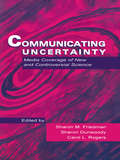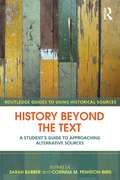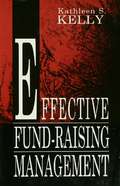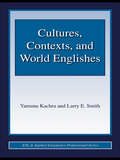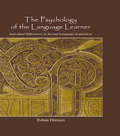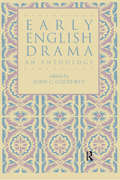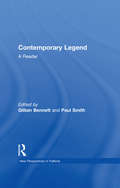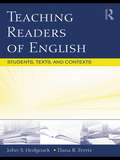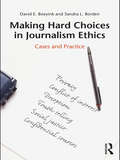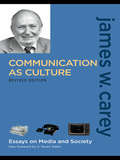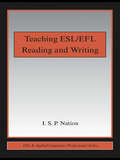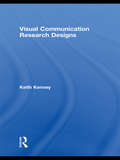- Table View
- List View
Communicating Uncertainty: Media Coverage of New and Controversial Science
by Sharon M. Friedman Sharon Dunwoody Carol L. RogersExploring the interactions that swirl around scientific uncertainty and its coverage by the mass media, this volume breaks new ground by looking at these issues from three different perspectives: that of communication scholars who have studied uncertainty in a number of ways; that of science journalists who have covered these issues; and that of scientists who have been actively involved in researching uncertain science and talking to reporters about it. In particular, Communicating Uncertainty examines how well the mass media convey to the public the complexities, ambiguities, and controversies that are part of scientific uncertainty. In addition to its new approach to scientific uncertainty and mass media interactions, this book distinguishes itself in the quality of work it assembles by some of the best known science communication scholars in the world. This volume continues the exploration of interactions between scientists and journalists that the three coeditors first documented in their highly successful volume, Scientists and Journalists: Reporting Science as News, which was used for many years as a text in science journalism courses around the world.
Communicating Uncertainty: Media Coverage of New and Controversial Science
by Sharon M. Friedman Sharon Dunwoody Carol L. RogersExploring the interactions that swirl around scientific uncertainty and its coverage by the mass media, this volume breaks new ground by looking at these issues from three different perspectives: that of communication scholars who have studied uncertainty in a number of ways; that of science journalists who have covered these issues; and that of scientists who have been actively involved in researching uncertain science and talking to reporters about it. In particular, Communicating Uncertainty examines how well the mass media convey to the public the complexities, ambiguities, and controversies that are part of scientific uncertainty. In addition to its new approach to scientific uncertainty and mass media interactions, this book distinguishes itself in the quality of work it assembles by some of the best known science communication scholars in the world. This volume continues the exploration of interactions between scientists and journalists that the three coeditors first documented in their highly successful volume, Scientists and Journalists: Reporting Science as News, which was used for many years as a text in science journalism courses around the world.
History Beyond the Text: A Student’s Guide to Approaching Alternative Sources
by Sarah Barber Corinna Peniston-BirdHistorians are increasingly looking beyond the traditional, and turning to visual, oral, aural, and virtual sources to inform their work. The challenges these sources pose require new skills of interpretation and require historians to consider alternative theoretical and practical approaches. In order to help historians successfully move beyond traditional text, Sarah Barber and Corinna Peniston-Bird bring together chapters from historical specialists in the fields of fine art, photography, film, oral history, architecture, virtual sources, music, cartoons, landscape and material culture to explain why, when and how these less traditional sources can be used. Each chapter introduces the reader to the source, suggests the methodological and theoretical questions historians should keep in mind when using it, and provides case studies to illustrate best practice in analysis and interpretation. Pulling these disparate sources together, the introduction discusses the nature of historical sources and those factors which are unique to, and shared by, the sources covered throughout the book. Taking examples from around the globe, this collection of essays aims to inspire practitioners of history to expand their horizons, and incorporate a wide variety of primary sources in their work.
History Beyond the Text: A Student’s Guide to Approaching Alternative Sources
by Sarah Barber Corinna Peniston-BirdHistorians are increasingly looking beyond the traditional, and turning to visual, oral, aural, and virtual sources to inform their work. The challenges these sources pose require new skills of interpretation and require historians to consider alternative theoretical and practical approaches. In order to help historians successfully move beyond traditional text, Sarah Barber and Corinna Peniston-Bird bring together chapters from historical specialists in the fields of fine art, photography, film, oral history, architecture, virtual sources, music, cartoons, landscape and material culture to explain why, when and how these less traditional sources can be used. Each chapter introduces the reader to the source, suggests the methodological and theoretical questions historians should keep in mind when using it, and provides case studies to illustrate best practice in analysis and interpretation. Pulling these disparate sources together, the introduction discusses the nature of historical sources and those factors which are unique to, and shared by, the sources covered throughout the book. Taking examples from around the globe, this collection of essays aims to inspire practitioners of history to expand their horizons, and incorporate a wide variety of primary sources in their work.
Effective Fund-Raising Management
by Kathleen S. KellyIn a ground-breaking departure from existing works, almost all of which are how-to manuals based on anecdotal evidence, this is the first academic textbook on fund raising. By integrating practical knowledge with social science theory and research, it presents a comprehensive approach to the function, from its legal and ethical principles to the managerial process by which gifts are raised. Territory previously uncharted in the literature is explored, such as the historical and organizational contexts of contemporary practice. Explanations of programs, techniques, and publics introduce a new system for understanding fund raising's major concepts. Unlike efforts in established fields, most of the material represents original scholarship undertaken to produce a first-time text. The book's main purpose is to teach students about fund raising--a high-demand, high-paying occupation that will continue to expand into the 21st century as the need for trained practitioners exceeds the supply. During the last decade, fund-raising education moved into the formal classroom and away from an apprenticeship tradition of senior practitioners mentoring newcomers. Yet until now, there has not been a textbook to support this evolving professionalism. Faculty have been reluctant to define fund raising as an academic subject in the absence of a theory-based teaching resource, and courses usually have been assigned to part-time instructors hired from the practice. This textbook addresses the void. It is designed for graduate and upper-level undergraduate courses dealing with fund raising as a primary or secondary subject. Among its features, each chapter points out research gaps and opportunities--such as problems and theories for master's theses and doctoral dissertations--and ends with a list of suggested readings. The text is appropriate for the diverse academic areas in which fund raising, nonprofit management, and philanthropy are taught, including public administration, management, arts and humanities, education, social work, economics, and sociology. Because of its public relations orientation, it is particularly suited for courses offered in that discipline. Additional audiences are practitioners enrolled in professional development programs; CEOs, trustees, and others interested in self-study; and scholars who need serious literature on the subject.PROFESSIONAL PROMO PIECE COPY..............Recently, the field of fundraising seems to have taken a giant step backward. Rather than conducting principled efforts to support common political, educational, financial, or social causes, the entire process is making headlines as a venue offering opportunities for influence peddling, corruption and self-promotion. The need for a guide to ethical fund-raising management is greater than ever. Effective Fund-Raising Management addresses this need.The most successful fundraisers understand why certain practices are more effective than others. What works in one situation may not work in another similar--but slightly different--situation. That is why theoretical understanding is vital to fundraising professionals. To be an expert practitioner, one must have have enough theoretical understanding to adapt one's practice to a variety of situations. That is the purpose of Effective Fund-Raising Management--to provide the underlying theoretical and conceptual understandings that enable an effective practitioner to become an expert practitioner.Indispensable to fund-raising professionals, this invaluable resource: * reviews the entire scope of the fund-raising profession-- from its historical antecedents to the current legal, ethical, organizational, and theoretical principles underlying its practice today;* provides concise definitions and explanations of the fund-raising process and its position within the field of public relations;* links effective fund-raising practices to ethical considerations; and * examines four of the major methods of fund raising-- annual giving, major gifts, planned giving, and capital campaigns.
Effective Fund-Raising Management
by Kathleen S. KellyIn a ground-breaking departure from existing works, almost all of which are how-to manuals based on anecdotal evidence, this is the first academic textbook on fund raising. By integrating practical knowledge with social science theory and research, it presents a comprehensive approach to the function, from its legal and ethical principles to the managerial process by which gifts are raised. Territory previously uncharted in the literature is explored, such as the historical and organizational contexts of contemporary practice. Explanations of programs, techniques, and publics introduce a new system for understanding fund raising's major concepts. Unlike efforts in established fields, most of the material represents original scholarship undertaken to produce a first-time text. The book's main purpose is to teach students about fund raising--a high-demand, high-paying occupation that will continue to expand into the 21st century as the need for trained practitioners exceeds the supply. During the last decade, fund-raising education moved into the formal classroom and away from an apprenticeship tradition of senior practitioners mentoring newcomers. Yet until now, there has not been a textbook to support this evolving professionalism. Faculty have been reluctant to define fund raising as an academic subject in the absence of a theory-based teaching resource, and courses usually have been assigned to part-time instructors hired from the practice. This textbook addresses the void. It is designed for graduate and upper-level undergraduate courses dealing with fund raising as a primary or secondary subject. Among its features, each chapter points out research gaps and opportunities--such as problems and theories for master's theses and doctoral dissertations--and ends with a list of suggested readings. The text is appropriate for the diverse academic areas in which fund raising, nonprofit management, and philanthropy are taught, including public administration, management, arts and humanities, education, social work, economics, and sociology. Because of its public relations orientation, it is particularly suited for courses offered in that discipline. Additional audiences are practitioners enrolled in professional development programs; CEOs, trustees, and others interested in self-study; and scholars who need serious literature on the subject.PROFESSIONAL PROMO PIECE COPY..............Recently, the field of fundraising seems to have taken a giant step backward. Rather than conducting principled efforts to support common political, educational, financial, or social causes, the entire process is making headlines as a venue offering opportunities for influence peddling, corruption and self-promotion. The need for a guide to ethical fund-raising management is greater than ever. Effective Fund-Raising Management addresses this need.The most successful fundraisers understand why certain practices are more effective than others. What works in one situation may not work in another similar--but slightly different--situation. That is why theoretical understanding is vital to fundraising professionals. To be an expert practitioner, one must have have enough theoretical understanding to adapt one's practice to a variety of situations. That is the purpose of Effective Fund-Raising Management--to provide the underlying theoretical and conceptual understandings that enable an effective practitioner to become an expert practitioner.Indispensable to fund-raising professionals, this invaluable resource: * reviews the entire scope of the fund-raising profession-- from its historical antecedents to the current legal, ethical, organizational, and theoretical principles underlying its practice today;* provides concise definitions and explanations of the fund-raising process and its position within the field of public relations;* links effective fund-raising practices to ethical considerations; and * examines four of the major methods of fund raising-- annual giving, major gifts, planned giving, and capital campaigns.
Cultures, Contexts, and World Englishes
by Yamuna Kachru Larry E. SmithThis volume aims to familiarize readers with the varieties of world Englishes used across cultures and to create awareness of some of the linguistic and socially relevant contexts and functions that have given rise to them. It emphasizes that effective communication among users of different Englishes requires awareness of the varieties in use and their cultural, social, and ideational functions. Cultures, Contexts and World Englishes: demonstrates the rich results of integrating theory, methodology and application features critical and detailed discussion of the sociolinguistics of English in the globalized world gives equal emphasis to grammar and pragmatics of variation and to uses of Englishes in spoken and written modes in major English-using regions of the world. Each chapter includes suggestions for further reading and challenging discussion questions and appropriate research projects designed to enhance the usefulness of this volume in courses such as world Englishes, English in the Global Context, Sociolinguistics, Critical Applied Linguistics, Language Contact and Convergence, Ethnography of Communication, and Crosscultural Communication.
Cultures, Contexts, and World Englishes
by Yamuna Kachru Larry E. SmithThis volume aims to familiarize readers with the varieties of world Englishes used across cultures and to create awareness of some of the linguistic and socially relevant contexts and functions that have given rise to them. It emphasizes that effective communication among users of different Englishes requires awareness of the varieties in use and their cultural, social, and ideational functions. Cultures, Contexts and World Englishes: demonstrates the rich results of integrating theory, methodology and application features critical and detailed discussion of the sociolinguistics of English in the globalized world gives equal emphasis to grammar and pragmatics of variation and to uses of Englishes in spoken and written modes in major English-using regions of the world. Each chapter includes suggestions for further reading and challenging discussion questions and appropriate research projects designed to enhance the usefulness of this volume in courses such as world Englishes, English in the Global Context, Sociolinguistics, Critical Applied Linguistics, Language Contact and Convergence, Ethnography of Communication, and Crosscultural Communication.
The Two W's of Journalism: The Why and What of Public Affairs Reporting
by Davis Buzz" Merritt Maxwell E. McCombsIn this timely volume, the authors explore public affairs journalism, a practice that lies at the core of the journalism profession. They go beyond the journalistic instruction for reporting and presenting news to reflect on why journalism works the way it does. Asking current and future journalists the critical questions, "Why do we do it?" and "What are the ways of fulfilling the goals of journalism?" their discussion stimulates the examination of contemporary practice, probing the foundations of public affairs journalism. With its detailed examination of factors influencing current journalistic practice, The Two W's of Journalism complements and expands on the skills and techniques presented in reporting, editing, and news writing textbooks. The perspectives presented here facilitate understanding of the larger role journalism has in society. As such, the volume is an excellent supplemental text for reporting and writing courses, and for introductory courses on journalism. It will also offer valuable insights to practicing journalists.
The Two W's of Journalism: The Why and What of Public Affairs Reporting
by Davis Buzz" Merritt Maxwell E. McCombsIn this timely volume, the authors explore public affairs journalism, a practice that lies at the core of the journalism profession. They go beyond the journalistic instruction for reporting and presenting news to reflect on why journalism works the way it does. Asking current and future journalists the critical questions, "Why do we do it?" and "What are the ways of fulfilling the goals of journalism?" their discussion stimulates the examination of contemporary practice, probing the foundations of public affairs journalism. With its detailed examination of factors influencing current journalistic practice, The Two W's of Journalism complements and expands on the skills and techniques presented in reporting, editing, and news writing textbooks. The perspectives presented here facilitate understanding of the larger role journalism has in society. As such, the volume is an excellent supplemental text for reporting and writing courses, and for introductory courses on journalism. It will also offer valuable insights to practicing journalists.
The Psychology of the Language Learner: Individual Differences in Second Language Acquisition
by Zoltán DörnyeiResearch results over the past decades have consistently demonstrated that a key reason why many second language learners fail--while some learners do better with less effort--lies in various learner attributes such as personality traits, motivation, or language aptitude. In psychology, these attributes have traditionally been called "individual differences." The scope of individual learner differences is broad--ranging from creativity to learner styles and anxiety--yet there is no current, comprehensive, and unified volume that provides an overview of the considerable amount of research conducted on various language learner differences, until now.Each chapter in this new volume focuses on a different individual difference variable. Besides a review of the relevant second language literature, Zoltán Dörnyei presents a concise overview of the psychological research involving each topic. A key concern for the author has been to define the various learner factors as measurable constructs and therefore the discussion includes a summary of the most famous tests and questionnaires in each domain.A wide range of readers will benefit from this book--students in linguistics, applied linguistics, modern languages, and psychology programs; second language teachers participating in in-service training courses; and researchers in second language acquisition and psychology.
The Psychology of the Language Learner: Individual Differences in Second Language Acquisition
by Zoltán DörnyeiResearch results over the past decades have consistently demonstrated that a key reason why many second language learners fail--while some learners do better with less effort--lies in various learner attributes such as personality traits, motivation, or language aptitude. In psychology, these attributes have traditionally been called "individual differences." The scope of individual learner differences is broad--ranging from creativity to learner styles and anxiety--yet there is no current, comprehensive, and unified volume that provides an overview of the considerable amount of research conducted on various language learner differences, until now.Each chapter in this new volume focuses on a different individual difference variable. Besides a review of the relevant second language literature, Zoltán Dörnyei presents a concise overview of the psychological research involving each topic. A key concern for the author has been to define the various learner factors as measurable constructs and therefore the discussion includes a summary of the most famous tests and questionnaires in each domain.A wide range of readers will benefit from this book--students in linguistics, applied linguistics, modern languages, and psychology programs; second language teachers participating in in-service training courses; and researchers in second language acquisition and psychology.
Early English Drama: An Anthology
by John C. ColdeweyFirst Published in 1993. Routledge is an imprint of Taylor & Francis, an informa company.
Contemporary Legend: A Reader
by Gillian Bennett Paul SmithFirst published in 1996. Routledge is an imprint of Taylor & Francis, an informa company.
Contemporary Legend: A Reader
by Gillian Bennett Paul SmithFirst published in 1996. Routledge is an imprint of Taylor & Francis, an informa company.
Teaching Readers of English: Students, Texts, and Contexts
by John Hedgcock Dana R. FerrisA comprehensive manual for pre- and in-service ESL and EFL educators, this frontline text balances insights from current reading theory and research with highly practical, field-tested strategies for teaching and assessing L2 reading in secondary and post-secondary contexts. Teaching Readers of English: provides a through yet accessible survey of L2 reading theory and research addresses the unique cognitive and socioeducational challenges encountered by L2 readers covers the features of L2 texts that teachers of reading must understand acquaints readers with methods for designing reading courses, selecting curricular materials, and planning instruction explores the essential role of systematic vocabulary development in teaching L2 literacy includes practical methods for assessing L2 students’ proficiency, achievement, and progress in the classroom. Pedagogical features in each chapter include questions for reflection, further reading and resources, reflection and review questions, and application activities.
WJEC GCSE English And English Language Higher Student Book (PDF)
by Ken Elliott Barry ChildsWritten by chief examiners Ken Elliott and Barry Childs, this student book for WJEC GCSE English provides authoritative, grade-focused support to help every student get the best results.
The Book of the Thousand and One Nights
by J. C. Mardrus E. P. MathersFirst published in 1986. Routledge is an imprint of Taylor & Francis, an informa company.
The Book of the Thousand and One Nights
by J. C. Mardrus E. P. MathersFirst published in 1986. Routledge is an imprint of Taylor & Francis, an informa company.
Making Hard Choices in Journalism Ethics: Cases and Practice
by David E. Boeyink Sandra L. BordenThis book teaches students how to make the difficult ethical decisions that journalists routinely face. By taking a case-based approach, the authors argue that the best way to make an ethical decision is to look closely at a particular situation, rather than looking first to an abstract set of ethical theories or principles. This book goes beyond the traditional approaches of many other journalism textbooks by using cases as the starting point for building ethical practices. Casuistry, the technical name of such a method, develops provisional guidelines from the bottom up by reasoning analogically from an "easy" ethical case (the "paradigm") to "harder" ethical cases. Thoroughly grounded in actual experience, this method admits more nuanced judgments than most theoretical approaches.
Making Hard Choices in Journalism Ethics: Cases and Practice
by David E. Boeyink Sandra L. BordenThis book teaches students how to make the difficult ethical decisions that journalists routinely face. By taking a case-based approach, the authors argue that the best way to make an ethical decision is to look closely at a particular situation, rather than looking first to an abstract set of ethical theories or principles. This book goes beyond the traditional approaches of many other journalism textbooks by using cases as the starting point for building ethical practices. Casuistry, the technical name of such a method, develops provisional guidelines from the bottom up by reasoning analogically from an "easy" ethical case (the "paradigm") to "harder" ethical cases. Thoroughly grounded in actual experience, this method admits more nuanced judgments than most theoretical approaches.
Communication as Culture, Revised Edition: Essays on Media and Society
by James W. CareyIn this classic text, James W. Carey maintains that communication is not merely the transmission of information; reminding the reader of the link between the words "communication" and "community," he broadens his definition to include the drawing-together of a people that is culture. In this context, Carey questions the American tradition of focusing only on mass communication's function as a means of social and political control, and makes a case for examining the content of a communication—the meaning of symbols, not only the motives that originate them or the purposes they serve. He seeks to recast the goal of communication studies, replacing the search for deterministic laws of behavior with a simpler, yet far more challenging mission: "to enlarge the human conversation by comprehending what others are saying." This new edition includes a new critical foreword by G. Stuart Adam that explains Carey's fundamental role in transforming the study of mass communication to include a cultural perspective and connects his classic essays with contemporary media issues and trends. This edition also adds a new, complete bibliography of all of Carey's writings.
Teaching ESL/EFL Reading and Writing (ESL & Applied Linguistics Professional Series)
by I.S.P. NationUsing a framework based on principles of teaching and learning, this guide for teachers and teacher trainees provides a wealth of suggestions for helping learners at all levels of proficiency develop their reading and writing skills and fluency. By following these suggestions, which are organized around four strands – meaning-focused input, meaning-focused output, language-focused learning, and fluency development – teachers will be able to design and present a balanced program for their students. Teaching ESL/EFL Reading and Writing, and its companion text, Teaching ESL/EFL Listening and Speaking, are similar in format and the kinds of topics covered, but do not need to be used together. Drawing on research and theory in applied linguistics, their focus is strongly hands-on, featuring easily applied principles, a large number of useful teaching techniques, and guidelines for testing and monitoring, All Certificate, Diploma, Masters and Doctoral courses for teachers of English as a second or foreign language include a teaching methods component. The texts are designed for and have been field tested in such programs.
Visual Communication Research Designs
by Keith KenneyVisual Communication Research Designs provides a step-by-step guide for designing research involving visuals relevant to communications media. This volume explains the process from conceptualization to research questions, instrumentation, analysis, and reliability and validity checks. It also addresses the lack of sufficient methods to answer theoretical questions attending visual communication. This resource has been developed in response to the circumstance in which, in many cases, the methodologies used for verbal and textual communications are inappropriate or ineffective when applied or adapted for the study of visual communications. Additionally, research articles from ethnography, action research, rhetoric, semiotics, psychology, cultural studies, and critical theory often do not use examples appropriate to visual communication readers. To address these issues, this book explains in clear and straightforward language key research designs, including new methodologies, that are appropriate for scholars and students conducting visual communication research. Organized into three parts -- production, analysis, and effects of visuals – this research text provides guidance in using, interpreting and measuring the effects of visual images. It addresses such topics as: producing photographs and video that can be used as research data; interpreting images that already exist; measuring the effects of visuals and to understand their use by different groups. Ethical issues are included, as well as a discussion of the advantages and limitations of each method. "War stories" are provided by experienced researchers, who discuss a particular research project and explain pitfalls to avoid, as well as what to do when problems occur. The primary audiences are scholars, researchers, and students conducting research on motion pictures, video, television, photographs, illustrations, graphics, typography, political cartoons, comic books, animation, and other media with a visual component. Individuals will use this text whenever they need to conduct research that involves visuals in the media. The book will be a required text for advanced courses in visual culture, seminars on visual communication research, and other research methods courses integrating a visual component.
Andorra: Max Frisch
by Peter HutchinsonThis new edition of the German classic Andorra has been revised to meet the needs of today's student. Peter Huchinson's superb editorial material provides invaluble support in guiding the student through the play. This new edition contains: * A new, full introduction to the play's historical background * Student-friendly notes and critical commentary which are written in English and which appear on the same page as the text * Extensive annotation * An expanded vocabulary section * Revised page design that presents the text and notes clearly.
